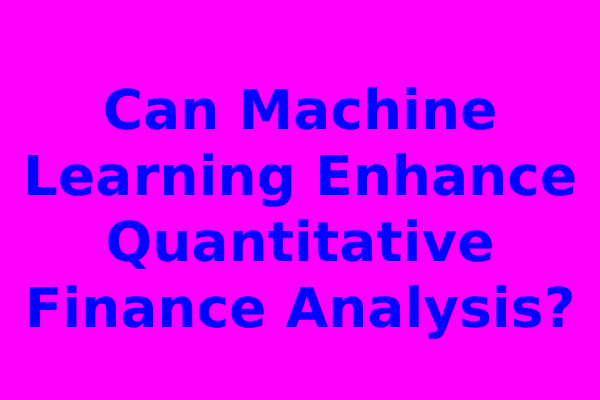Introduction:
In this article, I’ll explore the intriguing intersection of machine learning and quantitative finance, delving into the transformative potential of these advanced technologies to enhance financial analysis. Quantitative finance has long relied on mathematical models, statistical methods, and data analysis to make informed investment decisions and manage financial risks. However, the advent of machine learning has introduced a paradigm shift, offering unprecedented capabilities to process vast volumes of financial data, uncover hidden patterns, and refine predictive models.
The application of machine learning algorithms in quantitative finance is rapidly evolving, from algorithmic trading strategies to risk assessment, portfolio optimization, and fraud detection. We will delve into the ways in which machine learning can empower financial professionals to gain deeper insights, make more accurate predictions, and navigate the complexities of today’s dynamic financial markets. This article will shed light on the promising symbiosis of these two domains, demonstrating the potential for machine learning to revolutionize quantitative finance analysis.
ML and Quantitative Finance
In recent years, the integration of Machine Learning (ML) techniques with the field of Quantitative Finance has become a hotbed of innovation and discussion. This fusion holds the promise of revolutionizing traditional financial analysis by incorporating advanced computational methods and artificial intelligence. Machine Learning, a subset of artificial intelligence, is essentially a system that can learn from data, identify patterns, and make predictions or decisions without being explicitly programmed. Quantitative Finance, on the other hand, involves the application of mathematical and statistical tools to analyze financial data, manage risk, and make investment decisions. The marriage of these two domains is poised to empower financial professionals with more accurate and data-driven insights, ultimately reshaping the way financial markets are understood and navigated.
Traditional finance analysis methods have, for many decades, relied heavily on mathematical models, statistical tools, and historical data analysis to drive investment decisions. While these conventional approaches have yielded significant benefits and are still crucial in financial analysis, they have limitations when dealing with the complexity and sheer volume of data in today’s markets. This is where Machine Learning comes into play. With its ability to process large datasets quickly and efficiently, ML can uncover hidden patterns, detect anomalies, and generate predictive models that enhance traditional financial analysis methods. The synergy of ML and Quantitative Finance presents a new frontier where historic financial analytics meets cutting-edge technology.
As we delve further into this article, we’ll explore how the traditional methods of financial analysis have paved the way for machine learning to step in and augment these approaches. We’ll examine the capabilities of machine learning and how they can be harnessed in the financial realm, shedding light on the various aspects of quantitative finance that stand to benefit from this technological revolution.
Traditional Finance Analysis Methods
Traditional financial analysis methods have long served as the backbone of decision-making in the world of finance. These methods primarily involve the use of mathematical models, statistical techniques, and financial theory to evaluate investment opportunities, assess risk, and optimize portfolios. For instance, fundamental analysis delves into a company’s financial health and intrinsic value, while technical analysis focuses on price movements and historical trends. Both of these approaches provide valuable insights into investment decisions and have been the cornerstone of financial analysis for decades.
Furthermore, risk assessment in traditional finance relies heavily on tools like Value at Risk (VaR) and Monte Carlo simulations to estimate potential losses under different market conditions. These methods offer a structured and quantitative approach to understanding and mitigating risk. Additionally, portfolio optimization techniques, such as Modern Portfolio Theory (MPT) and the Capital Asset Pricing Model (CAPM), guide investors in constructing portfolios that maximize returns while minimizing risk.
However, these conventional methods have their limitations. They often assume that market conditions are stable and that historical data patterns will persist in the future. In today’s dynamic and interconnected financial landscape, these assumptions may not always hold. This is where the incorporation of machine learning introduces a dynamic element, allowing for more adaptable and data-driven financial analysis, which is explored in the subsequent sections.
Machine Learning Capabilities
Machine Learning (ML) is a subfield of artificial intelligence (AI) that has garnered substantial attention in various industries due to its ability to process and analyze vast amounts of data. In the context of quantitative finance, the capabilities of ML offer a transformative approach to financial analysis.
One of the primary strengths of ML is its capacity to handle Big Data. In the financial world, where data is generated at an unprecedented pace, this capability is particularly valuable. ML algorithms can swiftly process and extract valuable insights from large datasets, making them suitable for tasks like real-time market analysis and high-frequency trading.
Moreover, ML algorithms are designed to learn and adapt. They can identify patterns and trends in historical data, detect anomalies, and adjust their models accordingly. This adaptability is especially beneficial in finance, where market conditions can change rapidly. By continuously learning from new data, ML algorithms can provide up-to-date and relevant insights for investment decisions.
Additionally, ML can uncover non-linear and complex relationships within financial data that may be challenging for traditional quantitative methods to discern. This can lead to the discovery of hidden opportunities and risks that might otherwise go unnoticed. Techniques like deep learning, a subset of ML, have demonstrated impressive capabilities in areas such as natural language processing and image recognition, which can be applied to financial data analysis.
In the subsequent sections, we will delve into specific applications of ML in quantitative finance, highlighting how these capabilities are harnessed to enhance financial analysis.
Data Processing and Analytics
Machine Learning’s remarkable ability to process and analyze data is a cornerstone of its application in quantitative finance. Traditional finance analysis methods often grapple with the sheer volume and complexity of financial data, which can range from historical stock prices and economic indicators to news sentiment and social media activity. Machine Learning algorithms excel at efficiently handling this data deluge, enabling finance professionals to extract valuable insights.
Data preprocessing is a crucial step in the financial analysis workflow, and ML can automate and streamline this process. ML algorithms can clean, normalize, and transform raw financial data, making it ready for analysis. This includes handling missing data, removing outliers, and standardizing data formats. These tasks, when performed manually, can be time-consuming and error-prone. ML not only speeds up the process but also improves its accuracy.
Moreover, ML techniques such as clustering and dimensionality reduction can help identify underlying structures in financial data. This can lead to the discovery of distinct market segments, correlations, and anomalies, which are essential for making informed investment decisions. By applying ML analytics, financial professionals can gain a deeper understanding of the market dynamics and its various components.
Predictive Modeling in Finance
Predictive modeling is a fundamental aspect of machine learning’s role in quantitative finance. Traditional finance analysis methods have historically relied on historical data and mathematical models to forecast market trends and asset prices. However, machine learning brings a dynamic approach to prediction by leveraging its adaptability and data-driven insights.
ML algorithms excel at constructing predictive models that can forecast future financial events with a higher degree of accuracy. These algorithms can analyze a wide array of data sources, including market data, economic indicators, news sentiment, and even alternative data such as social media sentiments and satellite imagery. By identifying patterns and relationships within these datasets, ML models can generate predictions for asset prices, market trends, and even macroeconomic variables.
Furthermore, ML techniques like time series analysis and recurrent neural networks (RNNs) are particularly well-suited for forecasting in finance. Time series analysis allows for the modeling of temporal dependencies in financial data, making it a valuable tool for predicting stock prices and other time-sensitive variables. RNNs, on the other hand, are capable of capturing long-term dependencies, which can be crucial for understanding market behavior and predicting financial crises.
The predictive capabilities of machine learning extend beyond asset prices. ML algorithms can also be used for credit scoring, fraud detection, and customer churn prediction in the financial sector. These applications have far-reaching implications for banks, lending institutions, and insurance companies, where accurate predictions are essential for risk assessment and decision-making.
Algorithmic Trading Strategies
Algorithmic trading, also known as quantitative trading, is a prime area within finance where machine learning’s capabilities are highly influential. Traditional trading strategies have historically relied on human intuition and predefined rules to make trading decisions. However, algorithmic trading employs ML algorithms to analyze market data and execute trades with precision and speed.
ML algorithms can process real-time market data and identify patterns and opportunities that may be imperceptible to human traders. They can execute buy or sell orders in a matter of milliseconds, reacting to market movements with lightning speed. This high-frequency trading has the potential to capitalize on fleeting market inefficiencies and generate profits.
Reinforcement learning, a subfield of ML, is often used to develop algorithmic trading strategies. In reinforcement learning, agents learn to take actions in an environment to maximize a cumulative reward. In the context of trading, the reward may be the profit earned from executed trades. Over time, these algorithms can learn optimal trading strategies by trial and error, adapting to changing market conditions.
Algorithmic trading can also automate portfolio rebalancing and risk management. By employing ML, trading algorithms can continuously monitor the portfolio’s performance, adjusting the allocation of assets to optimize returns and mitigate risks. This real-time risk management can provide a significant advantage in volatile markets.
Portfolio Optimization
Portfolio optimization is a critical component of modern finance, where the goal is to construct an investment portfolio that maximizes returns while minimizing risk. Traditional approaches, such as Modern Portfolio Theory (MPT), have been the foundation for portfolio optimization for decades. MPT relies on mathematical models to find the optimal allocation of assets that balance risk and return.
Machine learning introduces a more dynamic and data-driven approach to portfolio optimization. ML algorithms can analyze a broader range of data sources, including alternative data sets like social media sentiment and news articles. By incorporating these additional data streams, ML models can gain a more comprehensive understanding of market dynamics and investor sentiment.
Additionally, ML can offer a more adaptable approach to portfolio rebalancing. Instead of relying on static allocation percentages, ML algorithms can continuously monitor the portfolio’s performance and adjust the asset allocation based on real-time market conditions. This dynamic approach can help investors respond swiftly to changing market trends and reduce exposure to high-risk assets.
Another facet of portfolio optimization involves the reduction of systematic and unsystematic risk. Machine learning techniques can assist in identifying and mitigating these risks by analyzing historical data and making predictions. This predictive capability allows for a more proactive risk management strategy, reducing the portfolio’s exposure to unforeseen events.
Risk Assessment and Fraud Detection
In the realm of risk assessment and fraud detection, machine learning is an invaluable tool for financial institutions. Risk assessment is a fundamental aspect of financial decision-making, and ML enhances this process by providing more accurate and data-driven insights.
ML algorithms can evaluate a broad range of factors to assess credit risk, including historical financial data, credit scores, employment history, and even non-traditional data such as social media activity and online behavior. By analyzing these diverse data sources, ML models can provide more comprehensive and accurate credit risk assessments, which are critical for lending decisions.
Furthermore, fraud detection in financial transactions has become increasingly sophisticated thanks to ML. Traditional rule-based systems for fraud detection have limitations, as they can only identify known patterns of fraud. In contrast, ML algorithms can detect anomalies and emerging patterns that might not be explicitly defined in rule-based systems. These algorithms can adapt to changing fraud tactics and provide real-time fraud detection, reducing financial losses for both individuals and financial institutions.
Machine learning also has applications in regulatory compliance for financial institutions. By automating compliance processes, ML can help institutions meet regulatory requirements more efficiently and effectively, reducing the risk of penalties and legal issues.
Conclusion:
I hope this exploration has shed light on the transformative potential of machine learning in enhancing quantitative finance analysis. The synergy of traditional financial methods and machine learning capabilities presents an exciting frontier, offering unprecedented benefits in terms of data processing, predictive modeling, algorithmic trading, portfolio optimization, risk assessment, and fraud detection.
In the ever-evolving landscape of financial markets, machine learning’s adaptability and capacity to analyze vast datasets swiftly hold great promise. It not only empowers professionals to make more informed decisions but also provides an edge in managing risks and seizing opportunities. As the financial world continues to grapple with increasing complexity and volatility, the integration of machine learning offers a dynamic and data-driven approach to navigate these challenges.
The future of quantitative finance lies in the fusion of human expertise and machine intelligence. By harnessing the capabilities of machine learning, the financial industry is poised to embark on a new era of data-driven, predictive, and agile financial analysis, ultimately reshaping the way we understand and engage with financial markets.


